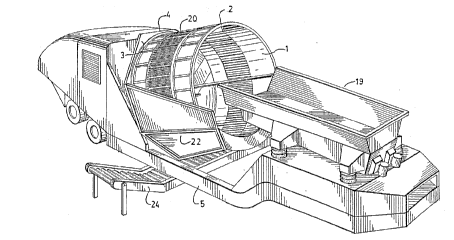Some of the information on this Web page has been provided by external sources. The Government of Canada is not responsible for the accuracy, reliability or currency of the information supplied by external sources. Users wishing to rely upon this information should consult directly with the source of the information. Content provided by external sources is not subject to official languages, privacy and accessibility requirements.
Any discrepancies in the text and image of the Claims and Abstract are due to differing posting times. Text of the Claims and Abstract are posted:
| (12) Patent: | (11) CA 2088638 |
|---|---|
| (54) English Title: | TUMBLE GRINDER WITH SCREEN PORTION |
| (54) French Title: | BROYEUR A CULBUTAGE AVEC GRILLAGE SEPARATEUR |
| Status: | Deemed expired |
| (51) International Patent Classification (IPC): |
|
|---|---|
| (72) Inventors : |
|
| (73) Owners : |
|
| (71) Applicants : |
|
| (74) Agent: | BORDEN LADNER GERVAIS LLP |
| (74) Associate agent: | |
| (45) Issued: | 1997-10-14 |
| (22) Filed Date: | 1993-02-02 |
| (41) Open to Public Inspection: | 1993-08-04 |
| Examination requested: | 1993-02-02 |
| Availability of licence: | N/A |
| (25) Language of filing: | English |
| Patent Cooperation Treaty (PCT): | No |
|---|
| (30) Application Priority Data: | ||||||
|---|---|---|---|---|---|---|
|
A tumble grinder is disclosed in which material
which is already sufficiently small in size, primarily being
abrasive aggregate or earthen material, may be discharged from
the receptacle to bypass the comminution apparatus and thus
substantially reduce wear thereto. A portion of the
cylindrical wall of the receptacle is provided with
classifying openings, for example by providing a screened
opening as a band around the receptacle. The classifying
openings permit material which is already smaller than the
size of the openings to fall therethrough, thereby bypassing
the comminution apparatus. Preferably, a conveyor is
positioned beneath the receptacle, to catch and discharge the
material which falls through the screen or other classifying
openings to a pile located away from the receptacle.
Sidewalls positioned on either side of the receptacle stop any
material which is flung out to the side, and redirect it down
onto the conveyer. The apparatus may be advantageously
mounted on a trailer, for towing from site to site. In such
an arrangement, it is advantageous to provide an integrated,
transportable system, in which the receptacle is moveable
between an operating position and a transportation position.
Broyeur à culbutage conçu pour laisser passer les matériaux (principalement des granulats abrasifs ou de la terre) dont les dimensions sont déjà suffisamment réduites, ce qui permet de diminuer l'usure de l'appareil. Le récipient comporte des ouvertures classeuses disposées en bande sur une portion de sa paroi cylindrique, par lesquelles passent les matériaux dont les dimensions sont inférieures au diamètre de ces dernières, contournant ainsi le dispositif de broyage. Un convoyeur est de préférence placé sous le récipient pour recevoir les particules de matériaux ainsi rejetées, et pour les mettre en tas, à l'écart du récipient. Des parois latérales placées de chaque côté du récipient arrêtent toutes les particules qui sont projetées à l'extérieur et les guident vers le convoyeur. Il serait préférable de monter l'appareil sur une remorque pour pouvoir le déplacer d'un endroit à l'autre. Dans ce cas, il faudrait prévoir un système transportable intégré, à récipient mobile à deux positions, c'est-à-dire position de fonctionnement et position de transport.
Note: Claims are shown in the official language in which they were submitted.
Note: Descriptions are shown in the official language in which they were submitted.

For a clearer understanding of the status of the application/patent presented on this page, the site Disclaimer , as well as the definitions for Patent , Administrative Status , Maintenance Fee and Payment History should be consulted.
| Title | Date |
|---|---|
| Forecasted Issue Date | 1997-10-14 |
| (22) Filed | 1993-02-02 |
| Examination Requested | 1993-02-02 |
| (41) Open to Public Inspection | 1993-08-04 |
| (45) Issued | 1997-10-14 |
| Deemed Expired | 2002-02-04 |
There is no abandonment history.
| Fee Type | Anniversary Year | Due Date | Amount Paid | Paid Date |
|---|---|---|---|---|
| Application Fee | $0.00 | 1993-02-02 | ||
| Registration of a document - section 124 | $0.00 | 1994-11-18 | ||
| Maintenance Fee - Application - New Act | 2 | 1995-02-02 | $100.00 | 1995-01-20 |
| Maintenance Fee - Application - New Act | 3 | 1996-02-02 | $100.00 | 1996-02-02 |
| Maintenance Fee - Application - New Act | 4 | 1997-02-03 | $100.00 | 1997-01-20 |
| Final Fee | $300.00 | 1997-06-25 | ||
| Maintenance Fee - Patent - New Act | 5 | 1998-02-02 | $150.00 | 1998-01-30 |
| Registration of a document - section 124 | $100.00 | 1999-01-11 | ||
| Maintenance Fee - Patent - New Act | 6 | 1999-02-02 | $150.00 | 1999-01-21 |
| Maintenance Fee - Patent - New Act | 7 | 2000-02-02 | $150.00 | 2000-01-26 |
Note: Records showing the ownership history in alphabetical order.
| Current Owners on Record |
|---|
| ASTEC INDUSTRIES, INC. |
| Past Owners on Record |
|---|
| DORSCHT, JOHN P. |
| HOGAN, PATRICK J. |
| PORTEC INC. |